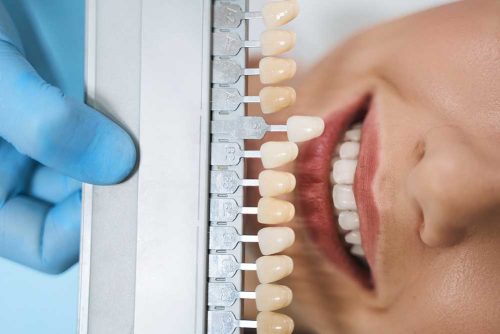
Stained, worn, chipped, or cracked teeth can significantly affect your confidence. Porcelain veneers are a popular cosmetic procedure that dentists use to correct or conceal these tooth imperfections.
Porcelain veneers are customized ultra-thin “shells” made of medical-grade porcelain and attached to the front surfaces of teeth. This type of porcelain is durable and is used to replicate the texture and shine of natural teeth. Porcelain Veneers act as a new enamel layer, so you can pick whatever shape or color you desire. Porcelain veneers will transform your smile.
On your first appointment, you will meet with your dentist and the dental team to discuss your goals and expectations for your new smile. The dental team will take your x-rays, pictures, and dental molds to determine if you are a good candidate for porcelain veneers. If you have extensive decay or significant dental issues, such as severe crowding or a deep bite, veneers may not be the best solution for you.
If the dentist determines that you are ideal for veneers, your teeth molds are sent to a dental lab. The dental lab makes a diagnostic wax-up. The dentist uses the wax-up to show you what your new teeth and smile will look like. Some dental labs will also create a template of the diagnostic wax-up using putty, and your dentist uses this to make you temporary veneers. These provisional veneers closely resemble the permanent porcelain veneers and allow you to “test drive” your new smile before fully committing.
The first step is for you and your dentist to pick a color for the veneers using a shade guide. After this, your dentist will numb you using a local anesthetic. When you are numb, the dentist removes a small enamel layer from each tooth to be veneered. This gives space so that there is enough room to place the veneers without affecting your bite. After removing the enamel layer, the dentist takes an impression of your teeth, and the lab uses this to fabricate your permanent veneers. The dentist makes temporary veneers and cements them temporarily to your teeth while you wait for your permanent porcelain veneers.
For your cementation appointment, the dentist will:
Porcelain veneers are a great way to conceal discolored, crooked, or cracked teeth but make sure to consider the pros and cons before getting them. Make an appointment with your dentist to find out if porcelain veneers are the best solution for improving your smile.
Hours
Monday 9:00 AM-6:30 PM
Tuesday 9:00 AM-8:00 PM
Wednesday 9:00 AM-5:00 PM
Thursday 9:00 AM-5:00 PM
Friday 9:00 AM-6:00 PM
Saturday, Sunday: Closed
©2022 Yonge & Eglinton Dental Clinic. All rights reserved.